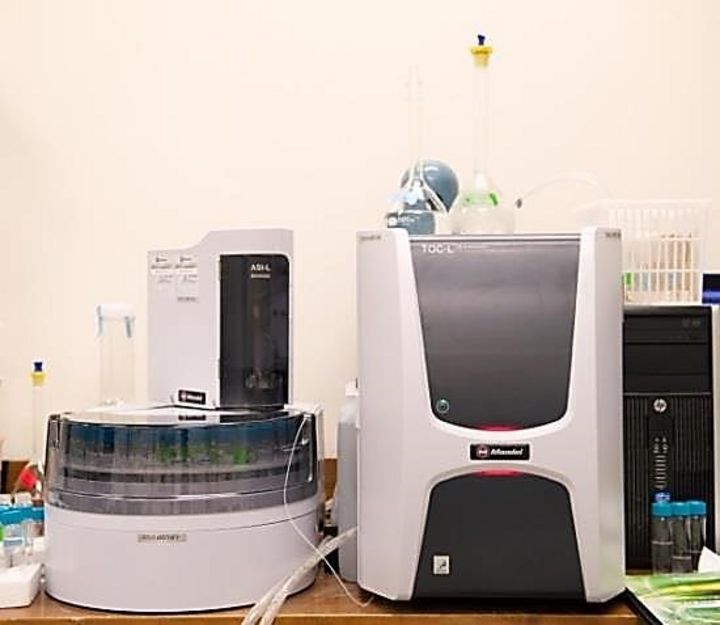
- Atomic absorption spectrophotometer (flame and graphite furnace)
- Automated titrator and Karl Fisher
- Capillary electrophoresis
- Differential Scanning Calorimeter (DSC)
- Fluorescence Spectrometer X (XRF)
- FTIR infrared spectrometer with cell specialized in gas and biogas analysis
- Fluorimeter
- Gas chromatograph (GC-TCD) for gas analysis
- Gas chromatograph (GC-FID)
- FTIR Infra-Red Spectrometer For Solid And Liquid Samples
- Ion chromatography
- Gas chromatograph combined with a mass spectrometer (GC-MS)
- High-performance liquid chromatography combined with an ion-trap mass spectrometry (LC-MS)
- High-Performance Liquid Chromatography (2 Units, One Of Which Is Equipped With A Fraction Collector)
- High-Performance Liquid Chromatograph With An ELSD Detector (Electrospray Light Scattering Detector)
- Kjeldahl analyzer (total nitrogen and ammonia)
- Spectromètre d’émission optique muni d’un plasma à couplage inductif (ICP-OES)
- Thermogravimetric analyzer coupled with mass spectrometer (TGA-MS)
- Total organic carbon analyzer
The Aquatic Bio-optics and Biogeochemistry Laboratory enables researchers to study the effects of climate change and permafrost thawing on lake water transparency and mixing dynamics and their multiple impacts on the microbial food chain, greenhouse gas emissions, and oxythermal habitat. Research at the Aquatic Bio-Optics and Biogeochemistry Laboratory also focuses on developing optical equipment for early detection of algal and cyanobacterial blooms and other problems related to water browning.
/// Features:
- Equipment and supplies sterilization by saturated steam
- Biological decontamination
- 508 x 508 x 965 mm, single door chamber
- Maximum volume of 249 liters
- Liquid and gravity programmed or programmable cycles
- Processes traceability
/// Features:
- Automated electrophoresis system for DNA, RNA, and protein samples
- Sizing, quantitation, and purity analysis
- Fast analysis requiring minimal sample volume
/// Features
- 60 bottles available, made of Borosilicate Duran® Schott glass
- Liquid volume capacity ranging from 50 to 200 mL
- Hermetically sealed, with robust aluminium septum and cap
- Initial or continued anaerobic gas purging (N2 80% / CO2 20%)
- Internal pressure tolerance of up to 10 psi
- Biogas analysis by GC-TCD (N2, O2, CO2, CH4) and FTIR (H2S)
- Measures the biogas pressure produced, using digital 0-3 or 0-15 psi nanometer.
/// Examples of applications:
- Assessment of the methanogen potential of organic inputs, in batch mode (~20 to 60 days)
- Assessment of sludge and complex sample biodegradability
- Monitoring of the effects of chemical/physical/enzyme treatment before biodigestion
- Assessment of the toxicity/inhibition of certain inputs on microorganisms
- Optimization of bioprocess input and co-input formulas and ratios
- Validation and calibration of mathematical models of reactions
Confocal microscopy and flow cytometry laboratoryThe laboratory is equipped with a four-laser LSRFortessa cytometer that allows high-level multiparametric analyzes to characterize cell populations. A BD FACS Calibur two-laser cytometer is used to perform routine analyzes such as the expression of surface markers. The Zeiss LSM780 confocal microscopy system is a state-of-the-art instrument for the study of various cellular and subcellular biological processes such as intracellular trafficking and localization of pathogen molecules.
/// Features:
- Gel Doc XR+ system allowing for high-resolution viewing (4 MP camera)
- UV or VIS imaging depending on the type of gel or sample (3 modes, trans-UV, trans white, epi-white)
- User-friendly, simple, and effective software
- Imaging, molecule weight analysis, and densitometry software
/// Examples of applications:
- Protein electrophoresis gel analysis (SDS-PAGE) (Photo, densito, mW)
- Analysis of agarose gel electrophoresis of DNA and RNA (Photo, densito, mW)
- Photo of colony bacteria on agars (Photo, densito, mW)
- Photo of halo of inhibition on petri dish or other
/// Features:
- Electrolysis and electrodialysis pilot system equipped with three 1-litre tanks
- Treatment capacity of 100 L per day depending on the type of samples treated
- Automated control system (pH, conductivity, temperature, and flow)
- Ion exchange and bipolar membranes (membrane electrolysis and electrodialysis)
- Pump with a maximum operating capacity of 3470 rpm (½ horsepower)
-15 000 Watt rectifier
/// Samples:
- Liquids
- Brines, hydrolysates, leachates, organic acid extracts
/// Examples of applications:
- Deacidification of cellulose hydrolysates
- Demineralization of leachates and food products
- Base production from salts
- Metal recovery from contaminated wash water
- Regeneration of mineral acids
- Separation and concentration of metal nanoparticles
This station is a common research area for all ÉTS professors and their public or private partners with a total surface area of approximately 703 m2. STEPPE-ÉTS is dedicated to the development and pilot-scale validation of technologies (knowledge and practices) to protect the environment at the preventive, remedial and curative level in a systemic perspective and responsible evolution of human activities. To develop technologies, knowledge and acquire information to protect the environment, the STEPPE-ÉTS infrastructure includes a pilot hall for large-scale studies, two metrological laboratories, a biological laboratory, a computer lab and two rooms with controlled environment.
In addition to these spaces, STEPPE-ÉTS's functionalities make it possible to access a fleet of analytical equipment and pilot treatment or remediation processes (water, atmospheric emissions, soils, residual materials). If a partner so desires, STEPPE-ÉTS can also put him in touch with other services or appropriate human resources to improve his project.
/// Features:
- Five 1.3-litre bioreactors with a 1-litre working volume
- Tanks enabling the addition of liquid (base, acid, antifoam, substrate feed)
- Possibility to use batch, fed-batch, and continuous processing
- Laboratory-scale fermentation bioprocess exploratory studies and development
/// Examples of applications:
- Aerobic and anaerobic fermentation bioprocess development
- Exploratory studies (O2 transfer rate tests, culture medium tests)
- Optimization of fermentation conditions (O2, ventilation, temperature, pH, agitation, feed)
- Preliminary assessment of bioprocess needs
- Screening tests of microorganisms (wild-type or recombinant); screening tests